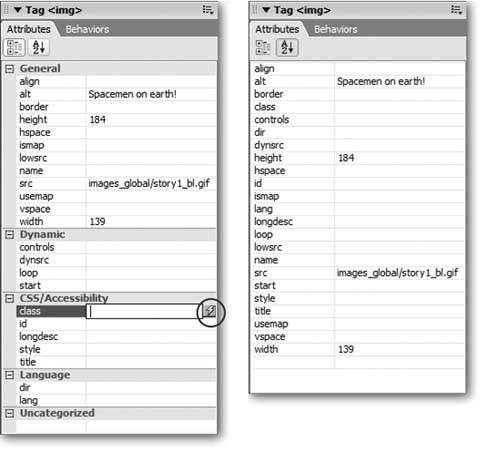Section 9.4. Tag Inspector
9.4. Tag InspectorThe Property inspector is a handy tool. With it, you can adjust properties for all sorts of HTML tags, like a table's width or a paragraph's font. But even the Property inspector doesn't tell the whole story: Some HTML tags have additional properties that don't appear there, such as the tabindex property of the <a> tag, which lets you control the order in which links are highlighted as the Tab key is pressed. You can set this property with the Tag inspector. As with tabindex , the properties listed in the Tag inspector are less frequently used, but you don't have to go into Code view to add or edit them. For these hard-to-reach properties, turn to the Tag inspector (see Figure 9-13). Think of it as the ¼berProperty inspector. For hard- core HTML fanatics , it's the best way to set properties for every HTML tag. To display it, press the F9 key, or choose Window When you select a tag on the page (in either Code or Design view), all of its properties appear in the panel. You can choose one of two views for displaying these properties: one long list, or grouped into tidy categories (see Figure 9-13). You can edit any of these properties by clicking in the space to the right of the property name . You can type a new value or, for certain properties, use a pop-up menu to choose from a list of property values. For color properties, use Dreamweaver's ubiquitous color box to select just the right shade . Figure 9-13. Dreamweaver's Tag inspector lets you edit every property of every tag on a page. What it lacks in user -friendlinessyou need to know a lot about HTML to use it correctlyit makes up for in comprehensiveness. It has two faces: Category view (left) and List view (right.) The List view is just that: a list of all properties for the selected tag. The Category view imposes a bit of order on this mess, by organizing the different properties into related categories. You can even set a property value dynamically based on information retrieved from a database, using the lightning bolt button (circled). (Of course, you must first learn how to build dynamic Web sites by reading Part Six of this book.) Unfortunately, you need to understand HTML fairly well to set the correct values; Dreamweaver doesn't make the process foolproof, leaving open the possibility that you could enter an invalid property. (To learn more about HTML tags and their properties, turn to Dreamweaver's built-in HTML reference, described on Section 9.6.) |
 Tag inspector (the same procedure also hides this panel).
Tag inspector (the same procedure also hides this panel).